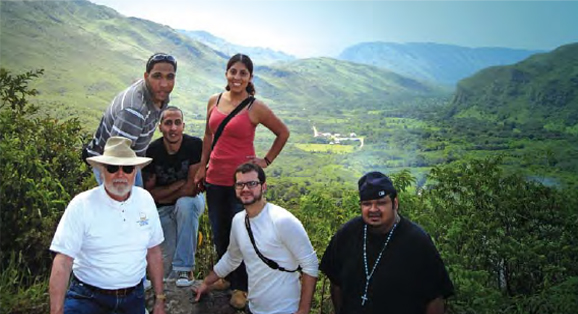Imagine a community virtually wiped out by a flood, where drinking water is a major health concern and windows that still have glass are rare. It is the kind of place most Americans have seen only on television. But a group from Wentworth traveled to South America to see such devastation firsthand—and, more important, apply their skills to doing something about it.
Beauty and Devastation
In 1982, Chirimoto, Peru, a small town in the Amazonas region, was destroyed in a severe flood. Most residents were forced to relocate. Nearly three decades later, only 200 residents remain and the legacy of the flood is still apparent in poor living conditions, inadequate health care, unsanitary water, and a high illiteracy rate. Electricity was only recently restored.
Professor Francis (Jerry) Hopcroft, Department of Civil, Construction, and Environment, first heard of the town’s plight from his Spanish instructor at Boston University (BU), Chirimoto native Luis Chavez. Chavez and his students had been helping to rebuild Chirimoto through BU’s Engineers Without Borders Program. As fate would have it, the group needed a civil engineering expert. So in June 2009, Hopcroft accompanied the group to Peru as its mentor.
On his first trip to what he calls one of the most beautiful places on earth, Hopcroft oversaw the design work for a water treatment plant and repairs to the community’s cultural center, La Casa del Colibrí (“the Hummingbird House”). The center also provides living space for visiting students and the caretaker’s family. In addition, Hopcroft established a bookmobile for local villages and met with residents to discuss economic development. After three successful weeks, the team returned home, but Hopcroft was eager to go back.
He formed a “dream team” of Wentworth students to accompany him on the next trip: Eric Danforth, BSA ’11, to design and oversee renovations to the Hummingbird House; Jose Arevalo, BCET ’11, and Starling Espaillat, BCET ’11, to manage a water treatment project; and Vinnie Rodriguez, BSM ’10, to serve as Hopcroft’s interpreter and assistant. Also chosen was MIT student Claudia Espinoza, to work on a wastewater management project. In December 2009, the group left for Peru. After a few days in Lima, they went on to Chirimoto by bus— a 25-hour trip up the coast and through the Andes.
Rebuilding the Basics
With the Hummingbird House, Eric Danforth faced a shell of a building. The stairway had been built in one day, the roof was not secure, and the floors were dirt in places. He analyzed the function of the space and began schematic designs. He then met with local hardware stores and material distributors to determine costs. He proposed an updated multifunction space for town meetings and recreation; modernized living quarters for the caretaker’s family; a renovated library; and dormitories and bathrooms for students. Back on campus, Danforth is refining his designs with the help of Hopcroft and a panel of professors. While incorporating modern considerations, his designs are considered vernacular, as they are derived from local building techniques and materials.
“I have learned that what really drives good architectural work is having an in-depth knowledge of how people would actually use a space,” says Danforth. “This understanding has shaped my architectural education.”
When Jose Arevalo and Starling Espaillat arrived in Chirimoto, they quickly established credibility with their fluent Spanish. Assigned to design an updated sand filter and piping system for removing bacteria from the water, they consulted with the local water department director and, along with Hopcroft, met with the mayor and the chairman of the water board. They also went about expanding a water distribution tank to provide a more reliable supply. Now Arevalo and Espaillat are finalizing their designs as part of their spring ’10 co-op semester. Once complete, the designs will be shared with engineers in Peru.
Vinnie Rodriguez played a key role as Hopcroft’s interpreter during detailed discussions of an economic development plan aimed at revitalizing the community and securing its future. Rodriguez was up for the challenge, but there was one catch: he would miss three weeks of classes. Due to his strong interest and work habits, his professors agreed he should go.
“His ability to communicate with the locals and help translate plans was invaluable,” says Hopcroft.
Rodriguez says the experience taught him a lot about international business and helped to solidify his career direction. Yet the biggest thing he learned was the importance of credibility, he says.
“In order to help these villagers, we have to gain their trust and enable them to take charge of their future development.”
The students continue their projects under Hopcroft’s direction, and at least one plans to return to Peru to oversee the completion.
Listening and Learning
While Chirimoto has learned from Hopcroft and his students, they in turn have learned from the community, the professor says. He remembers seeing Chirimoto for the very first time. He immediately realized the impact he and his team could have if they were to simply listen, make suggestions, listen more, and help the locals find their own way to good solutions.
“This is the essence of teaching, and teaching and learning are the essence of service learning projects,” he says. “It took me sixty years to figure out what I wanted to do with my life and four years to make it happen.”
–Silvana Guerci-Lena
Editor’s Note: Professor Hopcroft started the Chirimoto Development Project, Inc., a nonprofit organization, to help fund these initiatives, including semesters abroad and the co-op opportunities for Wentworth students.

